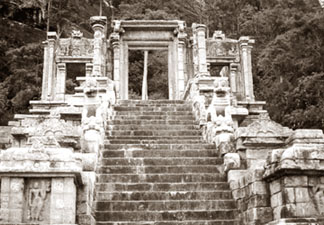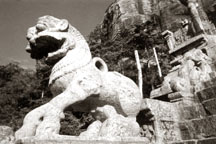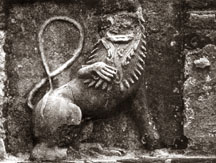|
observer |
|
|
|
|
|
OTHER LINKS |

|

|

|
A unique piece of historyStrong, dry breezes ruffle the quiet serenity of the temperate country side. Wild grass thrust through pleasantly undulating ground while a lone lizard revels in brilliant sunshine, poised on one of many ancient stone ruins.
It is also home to the singular Chinese-looking 'Yapahuwa Lion' stone sculpture, the likeness of which is reproduced in the country's newest Rs. 10 note. Historians compare Yapahuwa to the Sigiriya rock fortress but note that it was built on a much smaller scale. Its most remarkable masterwork remains an ornamental stairway that conducted the royal palace. Surrounding vistas of breathtaking beauty enriches the climb to the top; rambling jungle, rolling hills and sunbathed rocks combine to create a picture-perfect tableau. Yapahuwa is in the Pahala-visi-deka Korale, Wanni Hatpattu, of the Northwestern Province. Situated on the outskirts of Kurunegala, it is just three miles from the Maho railway station. For those choosing the rail option, hop off at the Maho station and either use the bus service that shuttles back and forth or, if adventurous enough, trek through the scenic countryside. The right footwear and a sun-hat are recommended for the entire expedition. The Yapahuwa rock rises abruptly from the plains. On its southern and eastern faces, terraces retained by walls permit access to the summit. The king had enclosed the city with a towering wall and a moat, protecting the palace within. A cave temple was built for monks at the apex. It still contains statues of the Buddha and paintings of the Kandyan period. Unlike Sigiriya, however, the palace was not constructed at the summit of the 91-metre flat-topped crag but on a lower level. Meanwhile, evidence suggests that the settlement on the rock was more urban than rural. Intriguingly, there is no mention of Yapahuwa beyond the 13th Century in Sri Lanka's historical sources. However, most recent archaeological excavations in Yapahuwa indicate that Buvenekabahu's hill top kingdom had close diplomatic ties with China. During early excavations, several Chinese ceramics were found. They are now known to be among the finest specimens discovered in the island.
From here, it was that Subha successfully prevented Magha's (1215-1236 AD) forces from marching southwards. Magha of Kalinga led an invasion of Sri Lanka with some 24,000 soldiers. A hundred years later, Tamil invaders were ousted from the country's north and the Sinhala monarchy was re-established in Dambulla. But the island remained susceptible to intruders from South India who stormed in from time to time. When Buvenekabahu made Yapahuwa his capital, he also moved the Sacred Tooth Relic of the Buddha from Dambadeniya to his chosen seat of governance. This was the practice of regents at the time and was a ritual of great political significance. After his death, however, Buvenekabahu's kingdom fell to the combined horrors of a sweeping famine and Pandyan invasion. The Pandyans took with them the Tooth Relic and hoards of other treasures. The Sinhalese were shattered by the loss of the Tooth Relic. To them, it signified the death of hope. The Pandyans soon left Yapahuwa but in the mid-16th Century, the Portuguese marched in. They demolished most of the magnificent buildings that were left standing, plundering and destroying splendid examples of eastern sculpture and architecture. The Kingdom, painstakingly raised from the ground, no longer stood in glory against the horizon but the ruins scattered around tell its tale eloquently enough, even today. These remains indicate that the palace was perched at the apex of its striking stairway and that two semi-circular walls and moats protected it. The stairway was originally in three stages. The first main flight is plain and starkly utilitarian. However, the last flight of 35 steps is highly ornate. These ruins are almost Cambodian in style, decorated with frames of exultant dancers musicians whose movements are so detailed and vibrant as to appear real. Dancers also adorn the porch above the steps. At the foot of each balustrade are the Yapahuwa lions, the only ones of its kind in the country. Visitors have noted that most of the steps are narrow and need to be manoeuvered in a sideways fashion. Historians say this was a form of defence. Because of the narrowness, the steps can neither be ascended nor descended hastily, thus giving those at the top time to arm themselves against an enemy onslaught or prevent infiltrators from fleeing easily. At the top of the stairs is a large stone door way, flanked by big walls and two exquisitely carved windows. During an 1850 excavation, one window was found in fragments but the other, called the 'Sivumenduru Kavuluwa' (perforated palace window), is well preserved at the National Museum in Colombo. Known as the gem of Yaphauwa sculpture, the window is a slab of stone four feet seven inches thick while the mouldings within are three inches in thickness. Its surface is punctured with 45 circles through which light entered the hall. The technique adopted in its construction has been compared to the tracery work at the Taj Mahal in Agra. Inside each circle is a figure, so finely sculptured as to back the statements that they are the best instances of medieval stone carvings in the country. Each is different from the other and includes Bacchanalian figures, women, swans and images of other animals. The last category also hosts eight creatures with trunks, identified as 'Gaja Sinhas' Alongside the palace is the Dalada Maligawa or Temple of the Tooth, built to hold the Sacred Tooth Relic. The structure resembles Dravidian architecture with panelled female forms like those found on the jambs of door-ways in Orissa. There is also a museum with relics found at the site. The summit of the Yapahuwa rock is accessible from this level by a rough path that leads off from the left of the temple. It is an enchanting climb but not for the fainthearted, although it is worth the effort. On the way up is a small cave with remnants of a small dagoba while near the peak is a natural water tank. On the top are remains of two more small dagoba and the ruins of other structures. The view is magnificent while the breezes are strong and refreshing. One gets the feeling of being miles away from noisy, modern civilization and the impression of being one with the past. Two miles from Yapahuwa is another site of historical interest. Situated at Pinwewa is an ancient burial site locally known as 'gal sohana kanatta' or graveyard of stone monuments'. Here, there are more than 40 chambered tombs with stone slabs. The first archaeological excavation at Yapahuwa was done by H. C. P. Bell, Sri Lanka's first archaeological commissioner who held the post from 1810 to 1811. Reports note that Bell found magnificent palace entrances or 'visithuru sopanas' during his work. Random exploration had continued throughout the years, but archaeologists believe there are more ruins to be dug out. People in the area say one proof of the existence of ruins underground is that during the rains, water seeps into the ground in an obvious pattern - soaking some areas and leaving others dry. Yapahuwa has more than one attraction to offer the visitor. Placed as it is in a relatively isolated corner of Sri Lanka's cultural triangle, it offers an encounter with the country's abundant past minus the teeming crowds regular 'touristy' atmosphere. Lulled by the secluded calm of the warm, welcoming countryside, one can truly lose oneself in meandering fantasies of a glorious past. Explore Sri Lanka |
 Overhead looms the Yapahuwa rock, 300-foot isolated fortified wonder
with a history dating back to the 13th Century. In that era, Yapahuwa
was Sri Lanka's seat of governance and home to the Sacred Tooth Relic of
the Buddha. Today it is one of the country's most unique and important
sites of historic interest containing abundant traces of ancient
battlements and remnants of king Buvenekabahu's (1273-1284 AD) kingdom.
Overhead looms the Yapahuwa rock, 300-foot isolated fortified wonder
with a history dating back to the 13th Century. In that era, Yapahuwa
was Sri Lanka's seat of governance and home to the Sacred Tooth Relic of
the Buddha. Today it is one of the country's most unique and important
sites of historic interest containing abundant traces of ancient
battlements and remnants of king Buvenekabahu's (1273-1284 AD) kingdom.

 Unearthed, too were a large number of celadon pottery pieces and more
than 1,000 Chinese coins. The history surrounding Yapahuwa rock is
fascinating. It is also called 'Subha pabbata' (or 'Subha's rock') after
a military leader named Subha who, perceiving the location's uses as a
brilliant point of military defence, made Yapahuwa his stronghold before
Buvenekabahu moved there.
Unearthed, too were a large number of celadon pottery pieces and more
than 1,000 Chinese coins. The history surrounding Yapahuwa rock is
fascinating. It is also called 'Subha pabbata' (or 'Subha's rock') after
a military leader named Subha who, perceiving the location's uses as a
brilliant point of military defence, made Yapahuwa his stronghold before
Buvenekabahu moved there. 






